A Guide to Doubling Returns for PPC – Testing Ideas Matter
Propelrr
February 23, 2023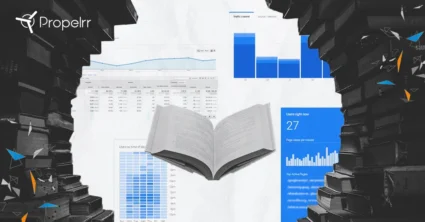
There’s much to gain in PPC and testing ideas for campaigns.
Pay-per-click (PPC) advertising isn’t uncommon in today’s digital marketing practice. But what many digital marketers neglect to do in PPC is testing ideas. This is because not many businesses have the time, people, knowledge, and/or tools to do it.
And while we can’t expect ourselves to be equipped with these at the beginning, it would be a grave mistake not to evolve and adopt ideas testing. Annually, advertising budgets rise because the premium on running them also increases. Add to that, the way search engines and social media algorithms have evolved has made it hard to capture and maintain placements.
These factors combined have made the importance of PPC and testing ideas no less obvious. To remain competitive, you have to experiment. Or else, you miss out on a lot of opportunities for growth or, worse, lose to your competitors.
RELATED READING: The Real Cost of Facebook Ads Versus Your ROI – Propelrr
But let’s dive into some specifics.
Why testing copies for PPC ads matters
The PPC management process has humbled a lot of marketers’ “marketing expertise” for many reasons apart from what’s mentioned above. Algorithms and budgets aside, audiences are hard to predict and grow increasingly desensitized to boring, irrelevant, or repetitive ads.
Hence, the creativity that comes attached as a requirement to your copies and ad creatives needs to be put to the test. Testing ad copies is simple enough, but will bring in more returns than you’d expect from an ad that you just pulled the trigger on on a whim.
The perfect message from your copywriting will inevitably:
- Lessen your costs. Testing helps you develop the best ad copies possible before you spend anything on an ad. That way, you don’t bleed resources while finding the copy with the best CTR.
- Maximize your revenue. Testing will make sure you get the most out of each ad spend. You’ll minimize costs and maximize wins with more clicks at a lower price, and more conversions with less cost.
- Allow you to scale your strategies. Testing every copy and CTA provides you with a rich well of data that tells you how to scale your strategies for the future. With all your data, you can maximize what you shell out and develop ads that adapt to the ever-changing landscape of digital marketing.
Now, let’s show you how you can run a few tests on your ad copies and, incidentally, your PPC ad campaigns.
Maximizing your campaigns for PPC through testing ideas
Optimizing PPC campaigns to achieve your desired business returns isn’t born from luck. It’s created through a formula – a methodical process of crafting ads, testing them, and analyzing which ones will rake in the best results.
It’s a given that ad copies must be creative, direct to the point, and have a clear call to action. In testing ideas, however, you have to double up on the creativity and nuance of each iteration. But before you do so, remember to establish a clear goal.
This will help guide you in tracking PPC campaign performance and staying focused, especially when you’re testing multiple ad creatives at a time. Work efficiently and avoid overthinking small things like using colons over semicolons, or whether “50% OFF” is better than “BOGO”.
Those, after all, can be addressed if you did your prior research and based your copies on historical data from Google Adwords optimization or other ad platforms.
To help you out, we’ve outlined a few steps you can follow to start testing ideas.
1. Create relevant and active ad copies.
Here’s an example: let’s say you already set up ads that are relevant to your campaign objectives, with the right targets, bids, and settings. You ran them for quite some time and did not get the results that you were expecting. Surprised? Don’t be.
With a firehose of online advertisements stampeding at every user, take a wide-open look at your copywriting – headline, description, display URL, and all. You’d never want to get a blank stare at your ad. One way to resolve this is to create different versions of ads for you to test out and measure their performance.
Look at the three variant examples below. Actively communicating the benefits, features, and killer CTAs in different versions will help you test which message is best consumed by your target audiences.

Always stick to your business objective. Never hesitate to mention unique offers in your advertisements, as your consumers say “Show me the product!” Be creative and relevant – all in terms of copy, landing page, and audience targeting.
2. Test what’s the best ad rank for you.
Holy Google! Packed with fantastic creatives and peppered with the lowest product or service offers, your ad is shown on top. Time for the much-awaited clicks and credit card appearances! Then suddenly, it just disappoints your inner gay.
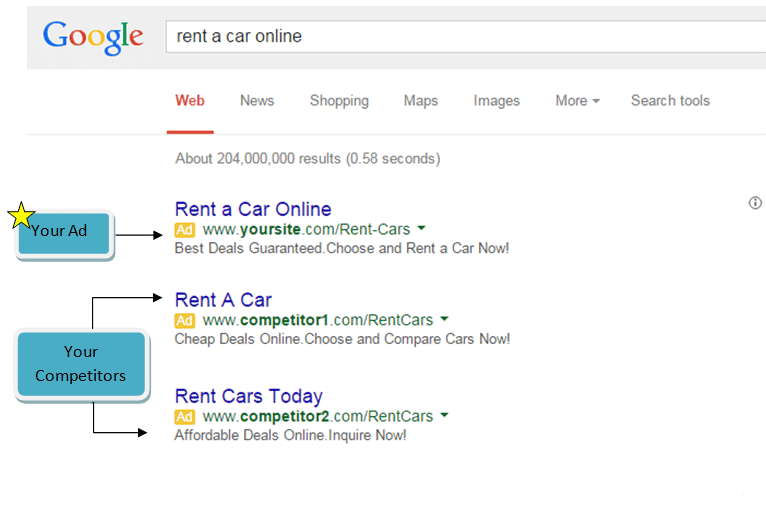
Top rank but gets low CTR? Now, we get to the “why” level.
Ad rank is what determines your ad position. Its main components are your bids, the quality of the ads, extensions, formats, keywords, and website. Your advertisement showing on top won’t necessarily equate to higher CTR.
Rather than going back to the first step of optimizing your campaign, start with the weightiest question – how are your competitors?
Gotcha! You have the same offers and you both target the same intent. Users might be skipping your ad because of personal comparisons; both your and your competitors’ ads meet their intent anyway.
Simultaneously fine-tune your audience knowledge and lower your costs by experimenting with ad rank. Try to bid down. Test the second or the third rank and see where you’re getting the most clicks.
3. Use custom URL parameters.
When mapping out PPC campaigns and ad groups, you’re probably targeting very similar keyword themes per group. Each specific keyword within the same group may carry different user intent than others. So based on user intent or your copy variants, you can choose to drive visitors to different landing pages or destination URLs.
Imagine you’re doing PPC for a brand of pizza and you have sets of keywords that represent specific flavors of pizza as part of the ad group. You can customize your headline, display, and destination URLs by mentioning your brand alongside a specific flavor like four cheese or pepperoni.
In this example, you can choose to send visitors directly to the category or product landing page, instead of leading them to the home page. This is where custom URL parameters are extremely helpful; if you have numerous ad copies with different variations, these parameters can help you specify copies that get the highest returns.
To do this, you’ll first have to create a database to list and group your ad copies along with their respective account, campaign, ad group, and destination URL. The variety of encoding schemes these days is dizzying, so for this, you can use Microsoft Excel or Google Sheets.
Here’s an example:
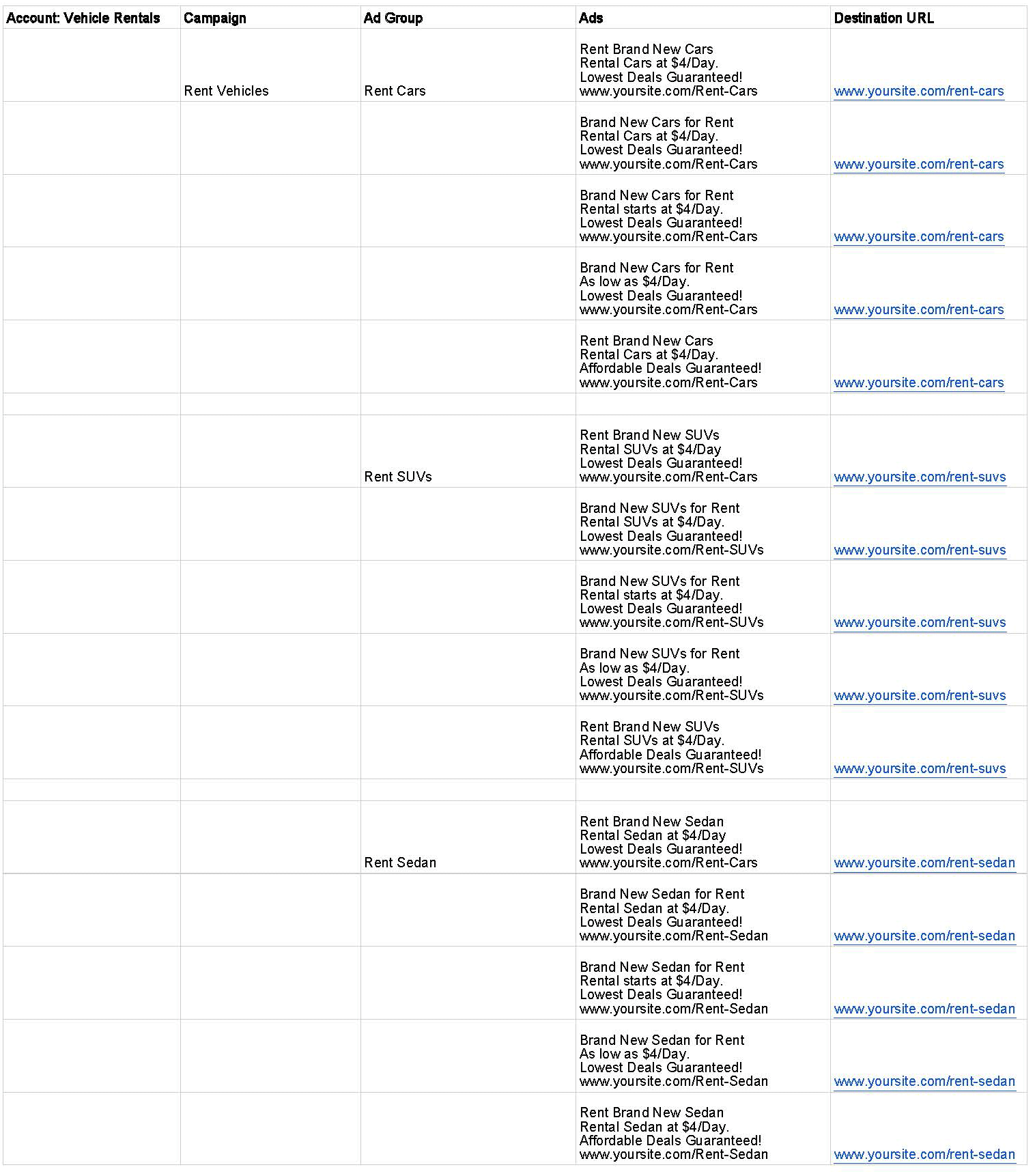
After organizing the ad copies, add URL parameters at the end of your destination URLs in the destination URL column. These should be unique per copy variation like what’s shown in this example below:
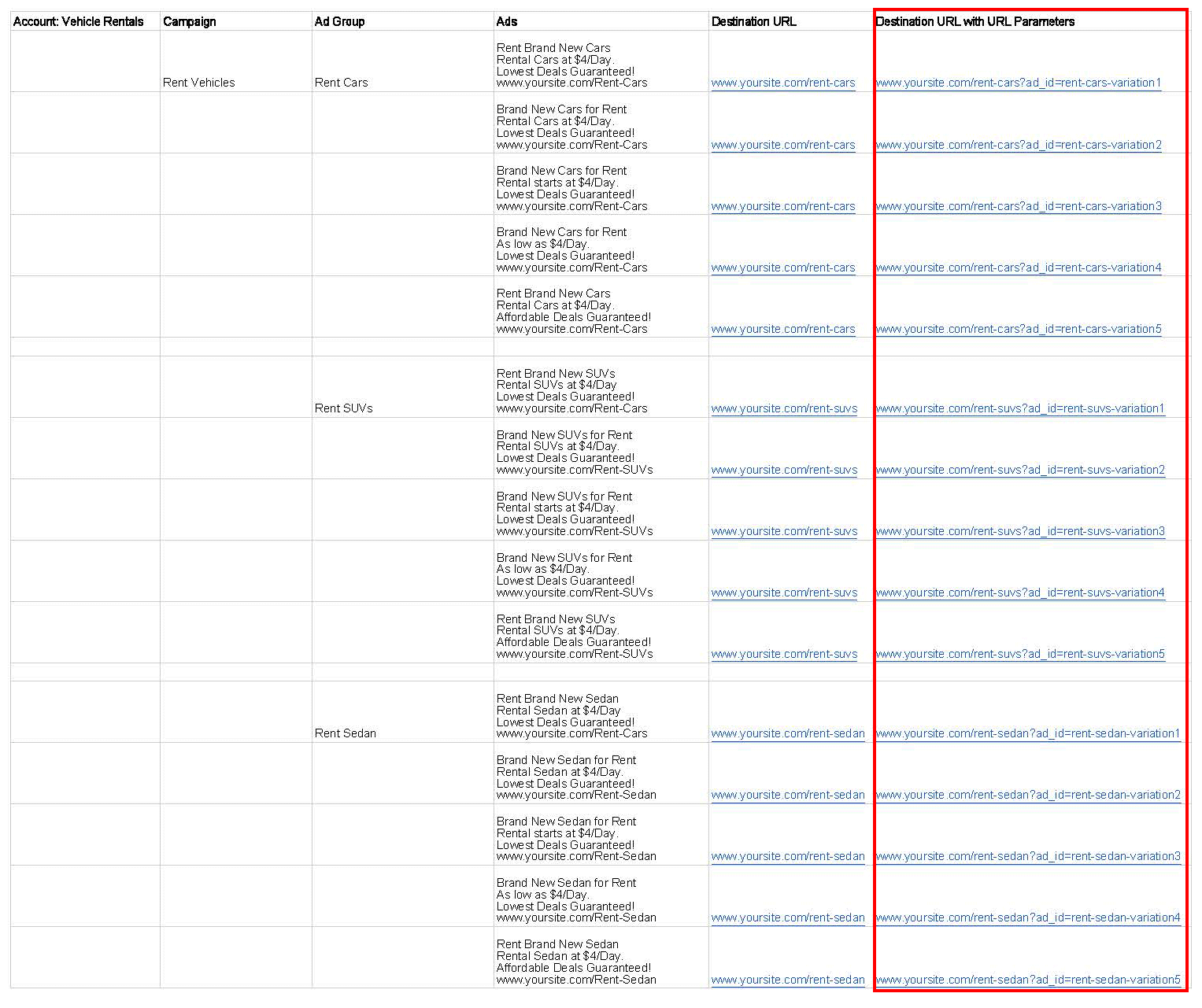
After that, you can start uploading your ad copies onto Google Adwords. Adwords Editor is best for faster implementation. Also, make sure that your URL parameter format is correct and working properly.

Does it make sense? Good. Your next step is…
4. Track them using Google Analytics.
Finally, we have come to the arena of data.
Don’t just toss your data around. Use Google Analytics to track what keyword works for your copy. Remember the URL parameters you did earlier? Use them like tags to ensure that you put URL parameters to every copy you want to test. Be sure not to name your custom parameter anything that will conflict with the parameters you set around your site.
To start analyzing your data, go to Google Analytics. Then select the account, project, and view for the website you’re conducting the test. Next, go to the reporting tab. On the left sidebar, go to Acquisition > Adwords, and then Destination URLs.
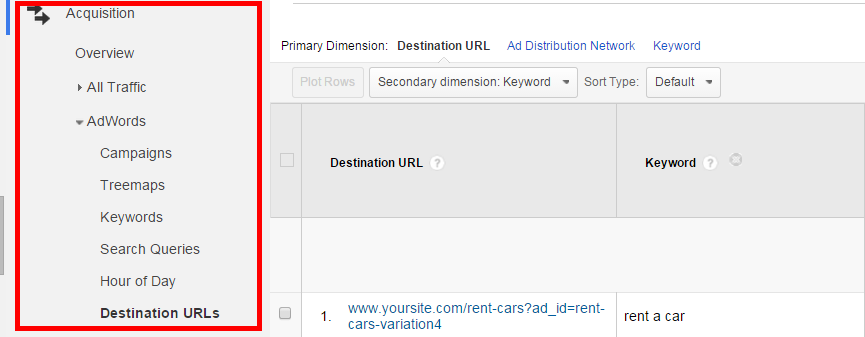
Once you’re there, put “Keywords” as your secondary dimension.
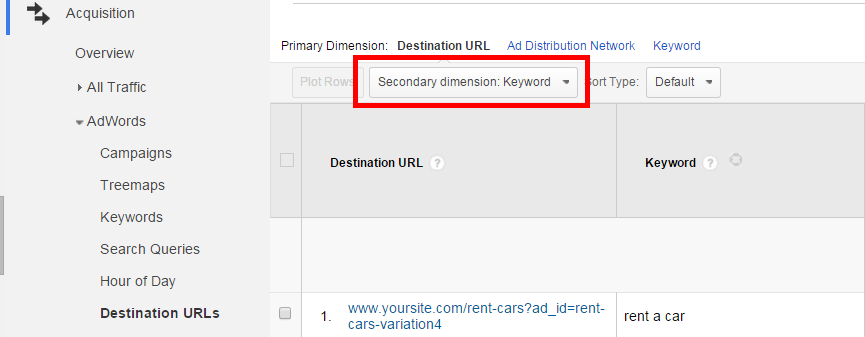
And voila! Like magic, you can now see what keywords are actually generating the most value (clicks, sessions, conversions, etc.) per ad copy.
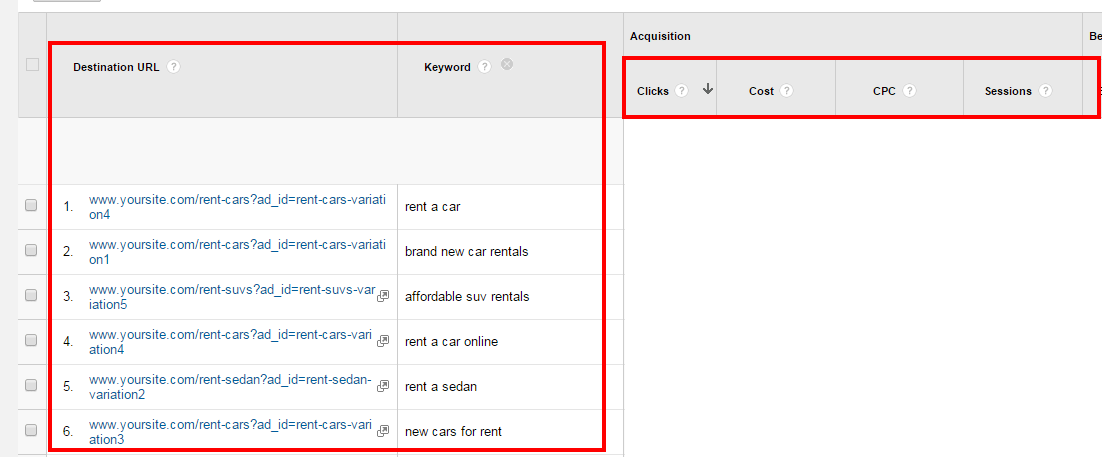
Now, go back to the database that you created to determine which Destination URLs belong to an ad copy. From here on out, you can do your optimization for a copy or even a landing page. You could make the keywords as an exact match for you to have lower costs, or you could change the color or position of a certain button on your landing page.
Data can either slap you straight with the cold hard truth for some Shakespearean inspiration, or validate your current effective strategy. Pay-per-click is more than thinking far outside the box.
5. Once there’s a champion, there will always be a challenger.
Testing Google Adwords ad copies must achieve two priorities: meeting your objectives and gaining insights from test isolation. Once you determine which copy, position, keyword, CTA, and hook work best for your campaign, it’s time for you to analyze, gather insights, and create your challengers.
The end result, when done right, is promising. However, the nature of digital platforms and the evolving consumer journey means it’s harder to get creative and pull more people in. The challenge is vicious, but rather than being scared, this challenge should excite you.
Bonus tips to improve your ad copies
Of course, you should never go into a vicious challenge alone. Here are a few bonus copywriting tips that you should take with you as you check your PPC performance:
- Practice brevity and clarity. Make it an everyday practice to follow these two most important elements of copywriting. That way, you’ll get used to stating points clearly without using too many words.
- Align visual hierarchies with content order. Your most important message should always be the first thing that readers see when a page loads. Then, make sure your copies are engaging enough for them to scroll down your content.
- Fix your copy noise. Never forget: clutter kills conversions. Don’t let your messaging go all over the place; have a specific goal for your copy and eliminate content noise that doesn’t support your page’s objectives.
- Practice emphatic copywriting. Emphatic storytelling resonates with audiences and helps resolve their pain points. Create clear and concise copies that tell them a meaningful story so that they’re better led to your desired outcome.
- Don’t just wait for feedback, ask for it. The early bird gets the worm, especially when it comes to feedback. Don’t just wait for people to tell you what’s wrong with your work; ask for feedback from bosses and colleagues to speed up your growth as an expert copywriter.
Key takeaways
There is no “best” when it comes to PPC ads testing, only better. Challenge your best practices when running your PPC campaign by remembering these three key takeaways:
- The ever-changing digital landscape makes it harder to pull people into your brand. So don’t forget that running a PPC campaign will also entail a never-ending process of optimization and improvement.
- Testing ad copies, therefore, is a critical step in optimizing for maximum returns. Want winning results? Then test your PPC ads copies. Don’t get lazy or intimidated; consistent and effective testing will ultimately result in minimized costs, maximized wins, and scalable strategies.
- Expert tips and advice are crucial to your success. If you can’t devote time and effort to manage your testing, then you need experts who can exert that time and effort to gain beneficial results out of your PPC ads optimization.
With Propelrr, dedicated expertise is just a click away. Drop us a line on Facebook, X, or LinkedIn to get excellent PPC campaign management today.
Want more bonus tips to improve your copywriting? Subscribe to our Propelrr newsletter to get the latest expert advice delivered straight to your inbox.